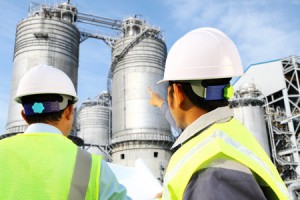Getting an As-Built Survey for an Oil and Gas Facility? Consider a BIM

If you’re in the process of building or retrofitting an oil and gas facility, getting an as-built survey is just one of many different things you’ll need to worry about. However, by employing the latest technologies, you can make sure that the process of getting a high-quality as-built survey is simple and efficient. As a result, you’ll have more time and resources to focus on actually completing your project.
In this post, we’ll discuss how building information modeling (BIM), created using 3D laser scanning technology, can help you get the best possible results from your as-built survey.
What Is 3D Laser Scanning and How Does It Apply to BIM?
With 3D laser scanning, a surveyor would set up a series of scanners that will let out thousands of individual laser points. After the laser points bounce off the building in question, their flight path will be tracked as they return to the scanner. Data from individual laser points will be compiled into a point cloud, which can provide a very detailed and accurate representation of the building and its composition.
The point cloud from a laser scan can then be used to create a BIM model, which is a 3D digital representation of the data provided by the scan. Many software platforms can even create the BIM models automatically for certain piping features. Creating BIM models based on data collected by 3D laser scans can help you in a number of ways.
They Help You Complete Projects Faster
Traditional surveying methods can be incredibly time consuming. A surveyor must enter the site and manually take points of the things they wish to survey. The process of assembling these points and formulating them into something that can actually be used to create an as-built survey is extremely slow and can often result in delays to the project itself.
On the other hand, laser scanning is a very quick process. Data is collected and assembled into a BIM model automatically, meaning that your team does not have to wait to get the as-built survey they need.
They Help You Reduce Potential Errors
Individual points are not always reliable when it comes to as-built surveys, as they can be affected by line of sight or GPS errors inside of the facility.
On the other hand, surveying based on laser scanning is both very detailed and accurate. The data gathered by 3D laser scanners will always be the same, no matter what conditions they are acquired in. This, in turn, means that the BIM models you create using laser point clouds will always be accurate. The 3D model you end up with will always be a model of what actually exists. Once you have the BIM, you can use it to make project decisions with confidence.
They Help Reduce Construction Costs
Finally, it’s important to think about how you can keep costs down as you complete your as-built surveys. Traditional surveying methods can lead to inflated costs, because they require more man hours to complete. In addition, the fact that these surveys aren’t always accurate can contribute to expensive rework, while delays in completing these surveys make it harder to achieve a quick return on investment.
By contrast, BIM models based on 3D laser scanning are completed with a high degree of automation, meaning fewer man-hours, reducing the overall cost. Because they are so accurate, a BMI will also help you to reduce the number of costly errors that can pop up during a project, further reducing the cost for oil and gas companies.
3D laser scanning and building information modeling are certainly valuable tools to support your efforts to get a better as-built survey for your oil and gas facility. However, in order to make the most of the benefits offered by these technologies, you need to make sure you’re working with a land surveying partner that knows how to use them. To learn more, contact Landpoint or review one of our project examples to get a look at what we’re capable of.

